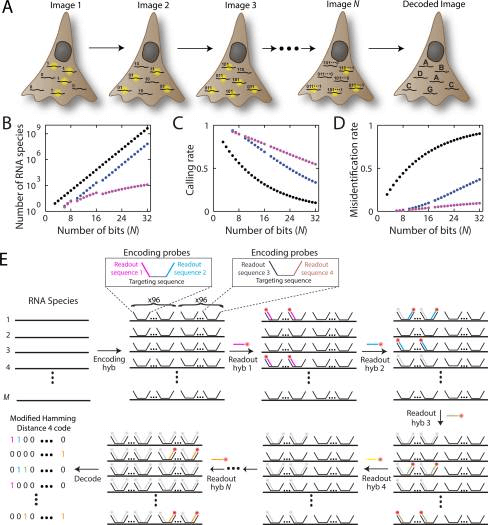Multiplexed Error Robust Fluorescence In Situ Hybridization
Multiplexed Error Robust Fluorescence In Situ Hybridization (MERFISH)
Single-molecule fluorescence in situ hybridization (smFISH) is one of the powerful tools for studying RNA copy number and spatial organization in single cells. The information obtained by smFISH technology can reveal the role of RNA subcellular localization in different biological processes such as cell migration, development, and polarization. A comprehensive systematic analysis of the abundance and spatial organization of RNA in a single cell can give us a more comprehensive understanding of the significance of many events in cell and developmental biologies, such as gene regulation mechanisms, heterogeneous behavior of cells, and cell development and maintenance fate. This method uses detection methods combined with high-resolution techniques to map the spatial distribution of specific RNAs. In addition, smFISH also has the ability to measure the copy number of a specific RNA, which makes it possible to quantitatively measure natural fluctuations in gene expression. The development of imaging and analysis methods has brought a leap in smFISH detection throughput. The recently developed multiple error robust fluorescence in situ hybridization (MERFISH) is a highly multiplexed smFISH imaging method that allows hundreds of smFISH measurements in a single cell in an automated manner. This greatly expands the horizons of RNA expression profiling and spatial organization analysis in different organisms.
 Fig 1. MERFISH: a highly multiplexed smFISH approach enabled by combinatorial labeling and error-robust encoding. (Chen K H, et al. 2015)
Fig 1. MERFISH: a highly multiplexed smFISH approach enabled by combinatorial labeling and error-robust encoding. (Chen K H, et al. 2015)
MERFISH Method
Quantitative measurement of copy number and spatial distribution of most transcriptomes in single cells can change researchers' understanding of various cell and tissue behaviors in health and disease states. The experimental protocol of MERFISH is appropriately adjusted on the basis of the general smFISH protocol. MERFISH enables simultaneous imaging of multiple RNAs in a single cell as well as data processing and analysis services using pre-set "barcoded" probes. Combinatorial labeling methods associate unique barcodes with individual RNA species, which are then read through a series of sequential hybridization and imaging measurements. The huge amount of data generated is analyzed by our bioinformatics methods, which can obtain high-quality data.
 Fig 2. MERFISH Methodology.
Fig 2. MERFISH Methodology.
Technology Features
- Transcriptome-scale quantitative measurement of the accurate copy number and spatial distribution of a single mRNA in a single cell in intact tissue
- The ability of large-scale multiplexing
- Unique error-resistant bar code method
Creative Bioarray provides custom oligonucleotide probe services to help customers realize the multiplexing capabilities of smFISH technology. You will benefit from our expertise and comprehensive platform. Our bioinformatics experts will work with you to find an efficient solution for your needs. If you are interested in our services, please contact us for cooperation. We look forward to cooperating with you in the near future.
References
- Moffitt J R, Zhuang X. RNA imaging with multiplexed error-robust fluorescence in situ hybridization (MERFISH)[J]. Methods in enzymology, 2016, 572: 1-49.
- Chen K H, Boettiger A N, Moffitt J R, et al. Spatially resolved, highly multiplexed RNA profiling in single cells[J]. Science, 2015, 348(6233).
All products and services on this website are only suitable for non-medical purposes.


 Fig 1. MERFISH: a highly multiplexed smFISH approach enabled by combinatorial labeling and error-robust encoding. (Chen K H, et al. 2015)
Fig 1. MERFISH: a highly multiplexed smFISH approach enabled by combinatorial labeling and error-robust encoding. (Chen K H, et al. 2015) Fig 2. MERFISH Methodology.
Fig 2. MERFISH Methodology.


